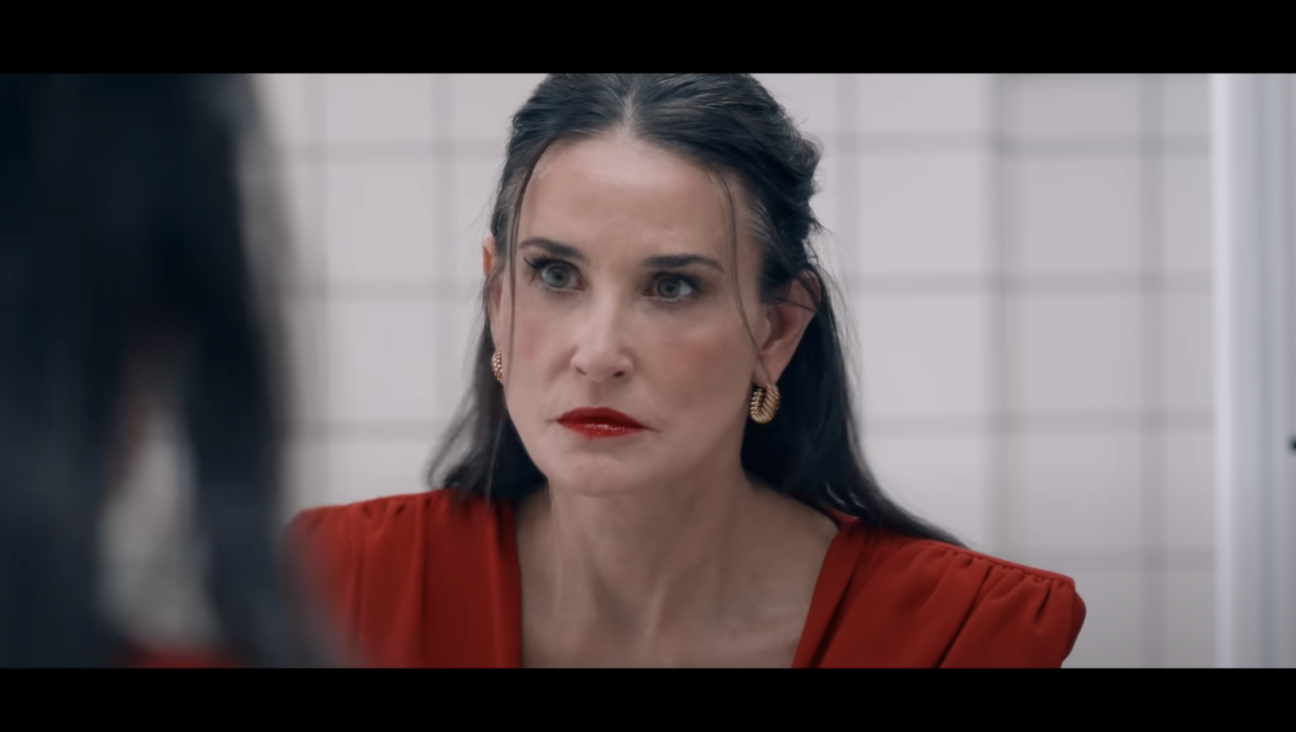How Roy Cohn’s Shame Made Him – And Trump – Shameless

Roy Cohn and Donald Trump Image by Getty/Sonia Moskowitz/Contributor
Everyone was afraid of Roy Cohn — until no one was.
A fixer, a liar, a self-loathing Jew and viciously homophobic homosexual, he seized on the Big Lie advanced by Adolf Hitler to advocate for his clients, smear his opponents and shield himself from a mountain of indictments. His first case to gain national attention sent Julius and Ethel Rosenberg to their deaths. Towards the end of his life, he was the consigliere of Donald Trump, pushing the young real estate scion to countersue the government in a housing discrimination case.
A physical and moral grotesque, called, in an extensive 1978 Esquire profile by Ken Auletta, “the personification of evil,” he relished his reputation as a prince of darkness.
Cohn was a walking picture of Dorian Gray. A scar on his nose — courtesy of a pediatric surgery that his image-conscious mother insisted on — would be joined by gill-like scars from a botched facelift in his middle age. While he maintained a 144-pound frame from a strict regime of sit-ups, performed in his home office facing a mirrored ceiling, his vanity couldn’t hide the ugliness that issued forth from his thin-lipped mouth.
His tongue, which was occupied at the tender age of 26 by smearing Communists and gay men as the chief counsel for Senator Joseph McCarthy, had a habit of peeking out in a reptilian fashion. It issued slanders, falsehoods and invective. Also: Charm.
While one might expect that Cohn’s involvement with McCarthy would have ruined his social life when he returned to New York from DC, that same venomous tongue dripped honeyed, scandalous — and largely erroneous — news items to columnists George Sokolsky and Leonard Lyons, establishing his relevance in Manhattan society. Top tier clients like his childhood friend and Conde Nast chair S.I. Newhouse, the Catholic Archdiocese and Yankees owner George Steinbrenner got him past velvet ropes and kept his social invitations coming.
A lifelong Democrat who, nonetheless, helped Reagan get to the White House, he managed to stay in the liberal whirl. His friends included Norman Mailer, CBS News President Fred Friendly (who was instrumental in exposing the evils of McCarthyism on the March 9, 1954 Murrow broadcast), Democratic mayor Abe Beame and Studio 54 regulars like Andy Warhol.
While working on his 2018 documentary “Studio 54” in 2016, filmmaker and journalist Matt Tyrnauer spotted Cohn in the archival footage. He was hard to miss. The club’s lawyer, Cohn “threw himself in front of the camera,” Tyrnauer recalled in a phone interview with the Forward.
“He was, I believe the scientific word for it is ‘Media Whore.’ I kept thinking to myself, ‘where’s the Roy Cohn documentary?’”
Tyrnauer soon dismissed the idea of a film about Cohn. The only new angle he could see for Cohn, who died in 1986 of AIDS, disbarred, in debt and no longer a threat, was his one-time protegé Donald Trump, who seemed primed for a historic loss in the 2016 presidential election.
How Cohn’s playbook failed to win Trump the presidency wouldn’t make for compelling storytelling, as much as it might signal a win for America’s better angels. But then, the first Tuesday of November passed. Donald Trump was the president elect. The next day, Tyrnauer wrote the film’s treatment.
The finished film, “Where’s My Roy Cohn?,” which takes its title from a reported quote from Trump, distraught that former Attorney General Jeff Sessions failed to meet Cohn’s standard of loyalty, premiered September 20.
To Tyrnauer, Trump’s unprecedented win marks Cohn’s greatest achievement.
“Cohn, in my opinion would have been a bold footnote to American history if it weren’t for the electoral college victory of Donald Trump, when he is transformed into a modern Machiavelli who did the impossible: Created a president from beyond the grave.”
—
Others have noted how Roy Cohn’s ghost stage managed Trump’s campaign and presidency. Journalist Marie Brenner, a producer and collaborator on Tyrnauer’s film, who covered Trump in the early 1980s, pin-pointed the link in a 2017 piece for Vanity Fair. (Frank Rich concurred with his own piece nearly a year later.)
But Brenner thinks that Cohn, were he still around, would run the Oval Office differently.
“He would have been so much more a subtle inside player. He would not have had this chaos that was going on,” Brenner told the Forward.
Cohn was a savvy politico, born in the till of New York’s Favor Bank, the quid pro quo system on which the city ran. Both his mother, Dora, who came from a wealthy and well-connected family, and his father, Albert, a Democratic New York judge, knew how to get things done.
“They had every major politician around their dinner table,” Brenner said. “Roy was transactional from the age of 10.”
The origin story goes that Cohn’s first dalliance with bribery came when he fixed a parking ticket for his high school teacher — while he was still in high school.
At home he received lessons in backroom dealing; on the streets, he had an education in publicity, working as a runner for gossip columnist and right-wing demagogue Walter Winchell. Aware of how the law was flexible and public opinion was another court available to lawyers, Cohn pursued a legal career, graduating from Columbia Law School at 20. It was a conventional career path for the son of a jurist, but one taken for an unconventional reason.
“I very early in my life broke with tradition and left my Jewish upper-class-oriented life in New York and became a contradiction of everything I was supposed to stand for,” Cohn told Ken Auletta in a recording featured in the film.
The case that made him — the espionage trial of Julius and Ethel Rosenberg — was a prime example of Cohn’s law-skirting tactics, and the demons that propelled his career. Cohn saw the case as an opportunity to make his name as a ruthless prosecutor and recoup the status his family had lost.
“He had a score to settle,” Brenner said.
Bernard Marcus, Cohn’s uncle, was president of the Bank of the United States when the stock market crashed. The bank, whose clientele was primarily Jewish immigrants, was blamed for sparking the financial crisis — some believe the attribution was due to anti-Semitism — and Marcus was sent to Sing Sing. His uncle’s treatment became one of Cohn’s early obsessions.
“The family had been absolutely shamed when Bernard Marcus went to prison,” Brenner said. “Roy kept a scrapbook as a little boy of all the pictures of his uncle Bernie Marcus. He would show them to his babysitters. Once, his mother saw him doing this and she yelled and took the scrapbook away.”
When Cohn was vicious in pushing for Ethel and Julius Rosenberg’s execution — illegally communicating with Judge Irving Kaufman (who, ironically, called Cohn from a phone booth outside the Park Avenue Synagogue) — he may have been trying to lift the stigma of family shame. He was responding, his relatives suggest, not just to anti-Communist animus, but to its inevitable link to Jews like him.
“He was the definition of a self-hating Jew,” Cohn’s cousin Dave Marcus says in the film. “He wanted to show the world that he wasn’t Jewish.”
His work on the Rosenbergs got the attention of FBI chief J. Edgar Hoover, who Tyrnauer identifies as a prototype for what Cohn would become and, who some, including Tyrnauer, believe, was himself a closeted gay man.
Cohn learned something of Hoover’s brand of red-baiting, and soon the FBI director introduced the young lawyer to McCarthy, with whom Cohn had a chance to hound more Communists — many of them Jews — and gays. He was the voice in the senator’s ear as the witch trials mounted.
The quotable moment that sent McCarthyism crashing down comes from the televised Army-McCarthy hearings, when US Army Counsel Joseph Welch asked the senator, “At long last, have you no decency?”
Those hearings came about due to a personal vendetta — Cohn’s desire to “wreck the Army” for not favoring his friend, and purported object of his affections, G. David Schine. Brenner believes Schine returned to Cohn’s life in another form decades later.
“I was looking one day at pictures of young David Schine and young Donald Trump,” Brenner said. “I thought they were separated at birth. They were the same sort of physical type: Uber gentile, blond, Nordic.”
—
Cohn met Trump in 1973 at Le Club, a hot, member’s only discotheque and restaurant. He worked for the Trumps, until his death, taking no billable hours, according to Trump biographer and Village Voice reporter Wayne Barrett.
Both Trump and Cohn were Outer Borough boys — Cohn from the Bronx, Trump from Queens. They hit it off, with Cohn, already established in Manhattan, being Trump’s entree into a world his father’s real estate empire had yet to reach.
“Roy gave him a sense of who he could meet and how he could meet them,” Brenner said. “He took him to the right parties, introduced him to politicians, to celebrities. He introduced him to Barbara Walters and all of their friends.”
While Trump was Cohn’s physical opposite, he emulated him where he could, securing himself a Cadillac with “DJT” vanity plates, likely inspired by Cohn’s “RMC”-plated Rolls-Royce.
Trump admired Cohn’s pit bull demeanor, telling Auletta “The mere sending of a letter from Roy Cohn has saved us a lot of money.”
Cohn’s law partner, Stanley Friedman, who served simultaneously as Ed Koch’s Deputy Mayor, fast-tracked Trump’s plans to remodel the Commodore Hotel. The deal made Trump’s reputation and taught him how to grasp the levers of power in Manhattan. Cohn, knowing success was only as good as its publicity, also secured Trump puffy press coverage through The New York Post, an organ owned by his client, a new-to-the-city Australian expat named Rupert Murdoch.
For his part, Cohn enjoyed being needed.
“The first thing he said to me was, ‘Donald Trump cannot live without me. We speak on the phone, sometimes 30, 40 times a day,’” Brenner said.
While Cohn was boasting, she recalled, he was spinning his Rolodex and offering her Yankees tickets or a car to take her back to her apartment.
“I was surprised at how absolutely shameless he was about who he was. He had almost a kind of delight in being Roy Cohn,” Brenner said. “Underneath this social persona of needing to be liked, there was an absolute menace.”
There was also something puerile about the man. Cohn shared his townhouse with his mother until she died; he had a Disneyland sign reading “Roy’s Room” on his bedroom door; he liked exotic pets like llamas and dressing up for revels at Studio 54. He collected plush frogs and, also, people.
Cohn, who claimed to be engaged for some time to Barbara Walters, surrounded himself with young, male companions and players featured on Page Six. He was, by many accounts, loyal and generous to his friends. His clients valued him, because he went to great, and extralegal, lengths to defend them. Sometimes, he would go to the same great lengths to take advantage of them.
Cohn was indicted in 1964 for obstructing justice in trying to get clients off for stock fraud and in 1970 for violating Illinois banking laws in an attempt to gain major shares in two Illinois banks.
Once, in 1969, he was brought in for bribing a city appraiser, on which occasion, his lawyer suffered a heart attack and he provided his own defense — with no notes — for seven hours over two days.
“He was a natural monologist of his own corruption,” Brenner said.
—
In the 1980s, Cohn was advising President Ronald Reagan, who arranged his treatment at the National Institute of Health for what might have been Cohn’s biggest lie: The AIDS that was killing him, and that he insisted, until the very end, was liver cancer.
This period of Cohn’s life has been immortalized in a work of drama: Tony Kushner’s Pulitzer-winning two-part play, “Angels in America: A Gay Fantasia on National Themes.” In the play, Cohn is a central player, haunted by the ghost of Ethel Rosenberg and unable to accept himself for who he was, even as he deteriorated as a result of that identity.
Until Trump’s presidency went from pipe dream to reality, Tyrnauer argues, Kushner’s play might well have been the last word on Cohn’s legacy. Instead, “Angels,” set during the tail end of the Cold War, is perhaps more timely than when it premiered.
Trump’s desperate cry of “Where’s my Roy Cohn?” was used in advertising for Marianne Elliott’s 2017 revival of the play, accompanied by a picture of Nathan Lane, glowering in costume as the reviled fixer. Beneath him is the answer: “Here.”
The truth of where Roy Cohn is is well-known to Trump, who all but abandoned him as he was dying, disbarred, and within a few weeks of losing his law license.
Cohn is reported to have said of Trump’s distance,”I can’t believe he’s doing this to me. Donald pisses ice water.”
Trump can’t replace Cohn, the inimitable architect of his brand of Fake News, lies and manipulation of bald-faced facts. But many believe he’s been trying.
Trump may have begun with Cohn mentee Roger Stone — Cohn introduced them. For a moment, Michael Cohen seemed to some to fill the role. In May, Carl Bernstein, who exposed Stone’s old boss, Richard Nixon, said of William Barr, “Trump said he wanted his Roy Cohn; he’s got him now in the attorney general.” Just this week, Rudolph Giuliani, who took down Cohn’s mob clients, tried (and failed) to deploy Cohnian tactics while defending the president on CNN.
Brenner, who attributed Cohn’s eagerness to help Trump to his resemblance to David Schine, proposed another candidate: also Jewish, from a Democratic family, and another fan of Big Lie theory.
“When I first saw Stephen Miller’s face, immediately I thought, ‘Oh my God, Trump sees the young Roy Cohn. Seeing that face, it’s a comfort zone for him.’”
PJ Grisar is the Forward’s culture fellow. He can be reached at [email protected].






















